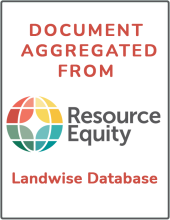Land Library Search
Through our robust search engine, you can search for any item of the over 73,000 highly curated resources in the Land Library.
If you would like to find an overview of what is possible, feel free to peruse the Search Guide.
/ library resources
Showing items 1 through 9 of 314.Umoja (noun):/ooh-moh-jah/Umoja, is the Swahili philosophy of unity. Its principles underscore the significance of cooperation and communal solidarity.
This report is a contribution of the knowledge management component of the LAND-at-scale programme (LAS) which is funded by the Netherlands Ministry of Foreign Affairs, and implemented by the Netherlands Enterprise Agency (Rijksdienst voor Ondernemend Nederland - RVO).
Although it is widely recognized that land tenure security is an integral part of agricultural intensification, there is no single clearly defined and universally applicable property rights regime to achieve this end.
This paper reviews the available data on men’s and women’s land rights, identifies what can and cannot be measured by these data, and uses these measures to assess the gaps in the land rights of women and men.
This booklet arises from GLTN's work on Islamic dimensions of land which began in 2004 with the commissioning of research leading to Sait and Lim’s “Land, Law and Islam: Property and Human Rights in the Muslim World” (London: Zed Press/UN-Habitat, 2006).
The following recommendations are made in this report:
1. The continuum of land rights is a metaphor, not a theory. A metaphor can be applied in a number of theoretical contexts, whereas a theory has an ideological perspective.
This paper reviews the experiences of introducing land consolidation and land banking instruments in Central and Eastern Europe, largely to address the structural problems of small and fragmented farms.
Growing populations and economic change resulting from globalisation and climate change are increasing pressure on land, particularly in urbanising countries. This exposes many of those occupying and using land, particularly the poor and women, to risks resulting from tenure insecurity.








